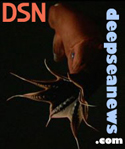 With the exception of bryozoans, every metazoan phylum with hard parts, and many that lack hard parts, made its first appearance in the Cambrian approximately 540 million years ago. This stunning and unique evolutionary flowering is termed the Cambrian Explosion, taking the name of the geological age in whose early part it occurred. But as Stephen Jay Gould often reminded readers, geologic explosions have very long fuses. The Cambrian explosion seems to have happened in a range of about 30 million years, and some stages took 5 to 10 million years. Still pretty quick in earth time.
With the exception of bryozoans, every metazoan phylum with hard parts, and many that lack hard parts, made its first appearance in the Cambrian approximately 540 million years ago. This stunning and unique evolutionary flowering is termed the Cambrian Explosion, taking the name of the geological age in whose early part it occurred. But as Stephen Jay Gould often reminded readers, geologic explosions have very long fuses. The Cambrian explosion seems to have happened in a range of about 30 million years, and some stages took 5 to 10 million years. Still pretty quick in earth time.A big question that remains is what set off this explosion of evolutionary diversity and innovation. A new paper in Science perhaps provides some interesting clues. Coralline sponges are members of the earliest branching metazoans (sponges) to secrete a calcium carbonate (CaCO3) skeleton. As a result of this evolutionary innovation, they were major contributors to the first metazoan reef-building processes in the early Paleozoic and Mesozoic eras. A sponge paleogenomics study by researchers in Germany and Australia demonstrates that not only were these sponges prolific reef builders, but that their ability to biocalcify was inherited from the first multicellular genetic toolkit from the last common ancestor.
 Calcification is a process perhaps more closely associated with corals than sponges. Corals are the main builders of the reef framework through the accumulation of limestone by the calcification process, but a diversity of other biocalcifying organisms (encrusting coralline algae, foraminifera, molluscs, and echinoderms) are also needed in the building of the reef. Coral calcification is intimately related to the internal symbiosis with zooxanthellae. The coralline sponge studied, Astrosclera willeyana, secretes CaCO3 in the form of aragonite through the presence of carbonic anhydrase, a gene family required for biocalcification.
Calcification is a process perhaps more closely associated with corals than sponges. Corals are the main builders of the reef framework through the accumulation of limestone by the calcification process, but a diversity of other biocalcifying organisms (encrusting coralline algae, foraminifera, molluscs, and echinoderms) are also needed in the building of the reef. Coral calcification is intimately related to the internal symbiosis with zooxanthellae. The coralline sponge studied, Astrosclera willeyana, secretes CaCO3 in the form of aragonite through the presence of carbonic anhydrase, a gene family required for biocalcification.Does the surge in early Cambrian calcification reflect a common inheritance of this key genetic toolkit, or did the ability to biocalcify evolve independently in different lineages? More analysis will be needed to answer these questions. But the authors infer that various modern metazoan lineages inherited this toolkit and have added to and elaborated upon its key elements to guide, enhance, and inhibit the deposition of CaCO3 in the spectacular variety of ways we see on todays reef systems.
Source: Science
Sponge Paleogenomics Reveals an Ancient Role for Carbonic Anhydrase in Skeletogenesis
Daniel J. Jackson, Luciana Macis, Joachim Reitner, Bernard M. Degnan, Gert Wörheide

















No comments:
Post a Comment